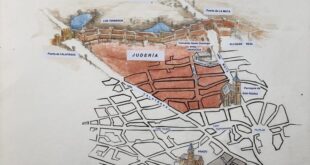
Malaga is in southern Spain on the Mediterranean coast in the province of Andalusia. Its temperate climate and wonderful beaches make it a holiday destination of choice for the northern sun-starved Europeans.
Pablo Picasso was born in Malaga in 1881 and left as a 14 year old.
According to the guidebook its history goes back 30 centuries and involves the Phoenicians, Greeks, Carthaginians, Romans, Byzantines, Christians and Muslims.
The Jews and the Syrians developed a strong trading base which continued even after the Muslim Caliphate was established in 711 CE. In 1487 Catholic monarchs re-conquered the city and incorporated it into the Kingdom of Castile. Five years later the Jews were expelled.
Traces of the Muslim presence are still seen in the fortresses of Alcazaba and Gilbralfaro. Of the Jews, almost nothing.
On Yom Kippur this year, I was in Malaga with my nephew who had sourced the street address of a shul – and we decided to go there.
We had to stop people to ask where the street was, but we could barely understand their replies, yet somehow we came across the shul with the aid of an inadequate tourist map.
The street consisted of nondescript office blocks, but walking along we saw a Jewish bookshop, which surprisingly, was open. I went in and asked a lady behind the counter where the synagogue was, but she replied, “No Englese”.
However, nearby we saw inside a building, by the front door, two men wearing yarmulkes. Also wearing them we approached them and they confirmed that the shul was indeed in that building. We had to take the rather small lift to the third floor.
We knocked on an ordinary looking door with an eyehole and it was opened immediately by a middle-aged man who let us in and motioned us to two seats in a somewhat ordinary- sized office-like room.
There were about 90 men present, seated, facing the bimah which was very slightly raised. Two other sets of seats were facing each other on both sides of the main body of seats. We were in a small section of three rows facing the entrance and sideways towards the bimah.
A congregant approached us and silently handed us each a tallis in a tallis bag and mouthed what I took to be words of welcome.
A rabbi was quietly conducting the service and it was obvious that the congregants were following closely because every now and again they chanted in unison.
Standing on either side of the rabbi, were two men. The one on the right would read something from a book in front of him. When he had finished his part, the other man called out a name and the person called, would go up to the bimah where he would commence reading together with the rabbi, I believe, as I could not actually see clearly from where I was sitting.
The person who had just stepped down would then go to each man in the shul, who would stand and shake his hand. After shaking hands that man would touch the fringes of his tallis and then bring his fingers to his lips, as is done when kissing a mezuzah.
It seemed that if the person going around knew one of the congregants well, or was a member of his family, then they would embrace and kiss each other lightly on each cheek.
There was a mechitsa on one side and it seemed to be quite full There was very little getting up and walking around, or leaving and re-entering and the men there seemed to be very deeply involved.
We remained there for about three hours and left shaking hands with those we passed on our way out. Actually we could have been in a shtiebel in Glenhazel, Durban or Cape Town, but the wonder was that all over the world Jews were basically davening the same words and displaying the unquenchable spirit of Judaism wherever it is to be found.
The next day we were in Cartagena, another ancient city on the Mediterranean coast and just by the harbour is a large tableau on the walls of a building, giving chronological dates of events in Carthaginian history.
In the year 1492 it says: “Salida Por Su Puerto De Los Judios Expusados De Espana.” (From this port the expelled Jews of Spain left.) Actually it does not need to be translated. We all know the history and the torment!
By LIONEL SLIER
Source: South African Jewish Report
 eSefarad Noticias del Mundo Sefaradi
eSefarad Noticias del Mundo Sefaradi

